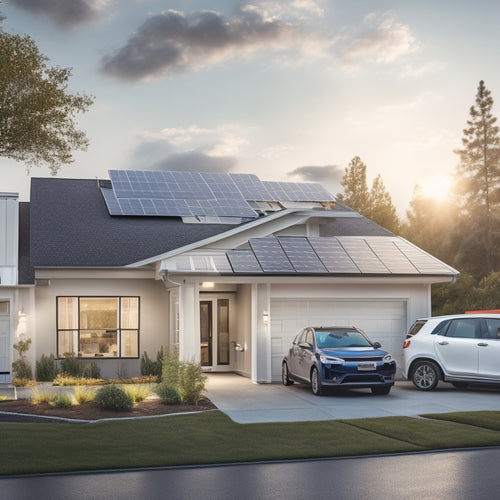
10 Essential Tips for Residential Panel Maintenance
Share
To guarantee your residential solar panel system runs efficiently, you'll want to schedule regular visual inspections based on panel age, clean your panels regularly to prevent dirt and debris buildup, and check for loose or faulty electrical connections. Inspect your mounting hardware and racking for stability, trim nearby trees and vegetation, and check your inverters and monitoring systems. Perform thermal imaging inspections and keep accurate maintenance records to track performance and trends. By following these essential tips, you'll optimize energy output, extend your system's lifespan, and prevent potential issues - and that's just the starting point for maximizing your system's full potential.
Key Takeaways
• Schedule regular visual inspections based on panel age to catch minor issues before they cause disruptions.
• Clean panels regularly to maintain efficiency, as dirt and debris can reduce energy output significantly.
• Inspect electrical connections regularly to prevent hazards like overheating and fires caused by loose or faulty connections.
• Check hardware and racking for stability and signs of corrosion, and apply rust prevention methods to extend lifespan.
• Implement pest control methods and seal entry points to prevent electrical issues, fires, or failures caused by infestations.
Schedule Regular Visual Inspections
Schedule Regular Visual Inspections
Regular visual inspections should be a priority in your residential panel maintenance routine, as they allow you to identify and address potential issues before they escalate into major problems. You don't want to wait until your panels are on the fritz, leaving you in the dark – literally! By inspecting your panels regularly, you'll catch minor issues before they become major headaches.
The frequency of your inspections depends on the panel's age. Newer panels (less than 5 years old) can get by with annual inspections, while older panels (5-10 years old) should be inspected every 6 months. If your panels are over 10 years old, you should check them every 3-4 months. This frequency ensures you'll catch potential issues before they become major problems.
Clean Panels for Optimal Performance
As you maintain your residential solar panels, you'll want to prioritize keeping them clean to guarantee maximum energy production.
Dirty panels can lead to significant energy losses, so it's crucial to remove dirt and debris regularly.
Dirt and Debris Removal
You can greatly enhance the efficiency of your residential solar panels by regularly clearing dirt and debris, which can reduce energy output by up to 25%. Soil accumulation and debris can have a profound impact on your panel's performance, making regular cleaning a vital maintenance task.
| Dirt/Debris Type | Impact on Panel Efficiency |
|---|---|
| Light dust | 5-10% reduction |
| Heavy dust | 10-15% reduction |
| Soil accumulation | 15-20% reduction |
| Leaves/branches | 20-25% reduction |
| Bird droppings | 25% reduction |
Weather resistance is also important, as panels exposed to harsh weather conditions can accumulate dirt and debris faster. To maintain peak performance, it is crucial to remove dirt and debris regularly. By doing so, you'll ensure your panels operate at their best, providing you with the maximum energy output. Remember, a clean panel is a happy panel!
Regular Cleaning Schedules
To guarantee your solar panels consistently operate at peak performance, establish a regular cleaning schedule tailored to your local climate and environmental conditions. You wouldn't want dirt, dust, and debris to diminish your energy output, would you? Regular cleaning promotes maximum energy production and prolongs the lifespan of your panels.
Weather resistance is key in determining the frequency of cleaning. If you live in an area with high levels of air pollution, proximity to the ocean, or extreme seasonal variations, you'll need to clean your panels more frequently. In contrast, if you live in a region with low humidity and minimal pollution, you might get away with fewer cleanings.
Seasonal variations also play a significant role in your cleaning schedule. For instance, during the dry summer months, you may need to clean your panels more often to remove accumulated dust and debris. In the winter, snow and ice may require more frequent cleaning to ensure energy production isn't compromised.
Check for Loose or Faulty Connections
When you inspect your residential panel, you'll want to check for loose or faulty connections. These can lead to connection failures that compromise the entire system. You're looking for signs of wear, overheating, or corrosion that can cause connections to fail, putting your electrical system at risk.
Connection Failures
Faulty connections can lead to system downtime, reduced efficiency, and even safety hazards, making it crucial to inspect and tighten all electrical connections regularly. You don't want to be stuck in the dark, literally, because of a loose screw.
When inspecting connections, keep an eye out for signs of wire corrosion, which can cause faulty wiring and lead to electrical shocks or even fires. Check for rust, corrosion, or water damage on wires and connections. If you notice any issues, it's important to replace them.
Tighten all connections firmly, but avoid overtightening, which can damage the wires. Make sure all connections are secure and not loose. A loose connection can cause a wire to overheat, leading to a fire hazard.
Don't take any chances – take the time to inspect and tighten your connections regularly. Remember, a well-maintained electrical system is a safe and efficient one. By staying on top of connection failures, you'll avoid costly repairs, reduce the risk of electrical shocks, and ensure your home remains safe and comfortable.
Electrical Surge Risks
Electrical surges can strike at any time, putting your home and appliances at risk. Loose or faulty connections can amplify this risk, making routine checks essential to minimize the potential for damage. You don't want to be caught off guard when a power outage hits, leaving you scrambling to restore order.
To avoid this chaos, make sure to inspect your connections regularly. Here are some key areas to focus on:
-
Tighten loose connections: Verify that all connections are secure and not loose. Loose connections can cause electrical arcing, which can lead to fires or electrical shocks.
-
Check for corrosion: Inspect connections for signs of corrosion, which can weaken the connection and increase the risk of electrical surges.
-
Protect against lightning strikes: Install surge protectors to shield your home from lightning strikes, which can cause devastating power surges.
- Schedule regular maintenance: Set reminders to inspect your connections regularly to prevent electrical surges and power outages.
Inspect Mounting Hardware and Racking
You should regularly inspect the mounting hardware and racking system to make sure it remains securely fastened to your roof. This important step maintains the structural integrity of your residential panel system, preventing costly damage and potential safety hazards.
When inspecting, look for signs of rust or corrosion on the hardware, as it can compromise the system's stability. Apply rust prevention methods, such as lubricating moving parts and coating metal components, to extend the lifespan of your system.
While inspecting, check for loose or damaged bolts, and tighten or replace them as needed. Verify that the racking system is securely attached to the roof, and that the panels are properly aligned and secured.
A well-maintained mounting system is essential for efficient energy production and longevity of your residential panel system. By staying on top of maintenance, you'll avoid costly repairs, ensure your system operates at peak performance, and enjoy the benefits of clean, renewable energy for years to come.
Verify Proper Electrical Connections
As you inspect your residential panel system, make sure all connections between components, including wires, inverters, and combiner boxes, are secure, clean, and free of signs of overheating or wear. You don't want any loose connections causing electrical shocks or fires, right?
To guarantee Wire Safety and Connection Reliability, follow these essential checks:
-
Tighten loose connections: Make certain all electrical connections are snug and secure to prevent electrical arcing or overheating.
-
Inspect for signs of wear: Look for frayed wires, corroded terminals, or damaged insulation, and replace them if necessary.
-
Check for overheating: Verify that connections aren't excessively hot to the touch, as this can indicate a potential fire hazard.
- Verify proper torque: Ensure that all bolts and screws are tightened to the recommended torque specification to prevent electrical connections from coming loose over time.
Look for Signs of Pest Infestation
During routine inspections, scrutinize your residential panel system for signs of pest infestation, such as rodent droppings, gnaw marks, or burrows, which can compromise the integrity of electrical components. You don't want any furry friends making themselves at home in your panel box!
Pests can cause significant damage, leading to electrical issues, fires, or even complete system failures. To prevent this, keep an eye out for signs of unwanted critters, and take prompt action if you spot any.
Implementing effective pest control methods is vital to maintaining your residential panel system. Seal any entry points, and consider using wildlife deterrents like rodent-resistant materials or repellents.
Don't wait until it's too late – addressing pest issues early on can save you from costly repairs or even a complete system overhaul. By staying vigilant and proactive, you'll ensure your electrical system remains safe, efficient, and pest-free.
Trim Trees and Vegetation Nearby
As you maintain your residential solar panels, don't forget to trim trees and vegetation nearby.
You'll want to remove any overhanging branches that could cast shade or drop debris onto your panels, and make sure that there's a safe distance between the foliage and your equipment.
Overhanging Branches Removed
Guarantee peak energy production and prevent potential damage by trimming any tree branches or vegetation that overhang your solar panel system. Overhanging branches can cast shade, reducing energy output, and even cause physical damage to your panels. Maintaining a safe distance between your solar panels and nearby trees or vegetation is vital.
Here are some tips to keep in mind when trimming overhanging branches:
-
Regular Tree Pruning: Schedule regular pruning sessions to prevent branch growth from encroaching on your solar panels.
-
Monitor Branch Growth: Keep an eye on nearby trees and bushes, and trim branches before they grow too close to your solar panels.
-
Hire a Pro: If you're not comfortable trimming branches yourself, consider hiring a professional to do the job.
- Inspect After Trimming: After trimming, inspect your solar panels to ensure they're clear of debris and functioning correctly.
Distance From Panels
Maintain a safe distance of at least three feet between your solar panels and nearby trees or vegetation to guarantee maximum energy production and prevent damage. This clearance is essential for best panel performance, as any obstruction can cast shade, reduce energy output, and increase the risk of panel damage.
| Obstruction Type | Recommended Clearance | Consequences of Non-Compliance |
|---|---|---|
| Tree branches | 3-5 feet | Reduced energy output, increased panel temperature |
| Shrubbery | 1-2 feet | Decreased air circulation, increased debris accumulation |
| Vegetation | 1-2 feet | Reduced energy output, increased risk of panel damage |
Regular Trimming Schedules
By keeping trees and vegetation at a safe distance, you'll need to establish a regular trimming schedule to prevent overgrowth and guarantee peak solar panel performance. This is important, as overgrown trees and vegetation can cast shadows on your panels, reducing their energy output.
To avoid this, create a seasonal maintenance plan that includes tree pruning strategies tailored to your region's climate.
Here are some tips to get you started:
-
Spring: Trim trees and shrubs to maintain a safe distance from your panels. Remove any dead or damaged branches to prevent damage from falling debris.
-
Summer: Focus on pruning back overgrown vegetation to ensure optimal sunlight exposure for your panels.
-
Autumn: Clear leaves and debris from your panels to prevent energy loss during the winter months.
- Winter: Inspect your panels for snow and ice accumulation, and clear them regularly to maintain energy production.
Check Inverters and Monitoring Systems
You should regularly inspect your inverters and monitoring systems to make sure they're functioning at their best and providing accurate data. After all, a faulty inverter can lead to reduced energy production and a lighter wallet.
When checking your inverters, look for signs of physical damage, corrosion, or overheating. Make sure all connections are secure, and the inverter's firmware is up-to-date. A highly efficient inverter is vital for maximizing your system's energy output, so it's important to guarantee peak inverter efficiency.
Your monitoring system is equally important, as it provides valuable insights into your system's performance. Check the monitoring system's data to identify any trends or anomalies that might indicate issues with your system. This data can help you pinpoint problems, allowing you to take corrective action and maintain system uptime.
Regular checks will help you catch potential issues before they escalate, ensuring your system runs smoothly and efficiently. By staying on top of inverter and monitoring system maintenance, you'll be enjoying maximum energy production and savings in no time!
Perform Thermal Imaging Inspections
Thermal imaging inspections can help detect potential hotspots in your residential solar panel system, allowing you to identify and address potential issues before they lead to energy losses or even system failures. By using thermal imaging, you'll be able to visualize thermal patterns and heat signatures that might be indicative of problems. This is especially useful for identifying issues that mightn't be visible to the naked eye.
Here are some key considerations to keep in mind when performing thermal imaging inspections:
-
Infrared analysis: Make sure you're utilizing a high-quality thermal imaging camera that can detect subtle changes in temperature.
-
Image resolution: Confirm that your camera has a high enough resolution to capture detailed images of your solar panels.
-
Heat signatures: Look for unusual heat signatures that might indicate faulty or malfunctioning components.
- Environmental factors: Take into account environmental factors like ambient temperature, humidity, and wind speed, which can impact your thermal imaging results.
Keep Accurate Maintenance Records
Keeping precise records of your residential solar panel system's maintenance history is essential for tracking performance, identifying trends, and optimizing future upkeep. You're not just keeping records for the sake of record-keeping; you're doing it to avoid compliance risks and guarantee your system runs smoothly. A well-organized filing system is vital for efficient record retention, making it easy to access essential data when you need it.
By analyzing your records, you can identify patterns and trends that inform your maintenance strategy.
When it comes to record organization, think digital – cloud-based storage or specialized software can help you stay on top of your records. This way, you can access your data from anywhere and reduce the risk of lost or damaged records. Plus, you'll be well-prepared for any audits that come your way.
Frequently Asked Questions
Can I Clean Solar Panels With Soap and Water?
When cleaning your solar panels, you're wise to avoid soap and water, as it can compromise panel durability. Instead, opt for deionized water to guarantee top-notch water quality, and a soft-bristled brush to gently sweep away debris.
How Often Should I Inspect My Residential Solar Panels?
You should inspect your residential solar panels on a routine schedule, ideally every 6-12 months, with seasonal checks after harsh weather conditions, to guarantee peak energy production and detect potential issues before they escalate.
Are Solar Panels Resistant to Hail and Extreme Weather?
You're wondering if your solar panels can withstand hail and extreme weather? Rest assured, they're built to last! Most panels are designed with weather resistance and storm durability in mind, so they can handle Mother Nature's tantrums.
Can I Install Solar Panels Myself to Save Money?
"Hey, DIY enthusiast! You're thinking of installing solar panels yourself to save some cash, but consider this: your lack of expertise could lead to DIY liability issues and compromised system performance, so assess your skill level honestly before taking the leap."
Do Solar Panels Generate Electricity During a Power Outage?
"When the grid goes dark, you're not stuck in the dark - if you've got a backup system in place, that is! You'll maintain grid independence, generating electricity during outages, but only with the right setup, buddy!"
Related Posts
-

What Electric Vehicle Owners Need for Home Energy
As an electric vehicle owner, you need to optimize your home energy system to guarantee efficient, sustainable, and c...
-

What You Need to Know About RV Solar Maintenance
When you're out on the road, your RV's solar panel system is your lifeline. But without regular maintenance, you're l...
-

Step-by-Step Guide to Converting Your Vehicle to EV
You'll begin by evaluating your vehicle's conversion potential, analyzing its weight, aerodynamics, and powertrain co...


